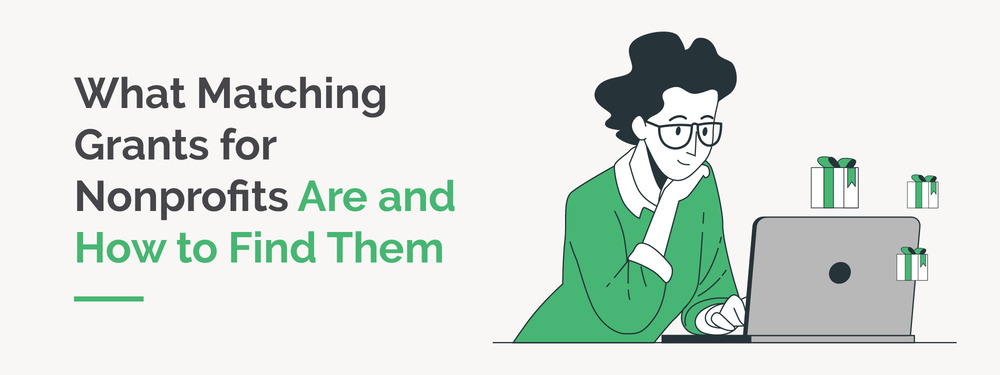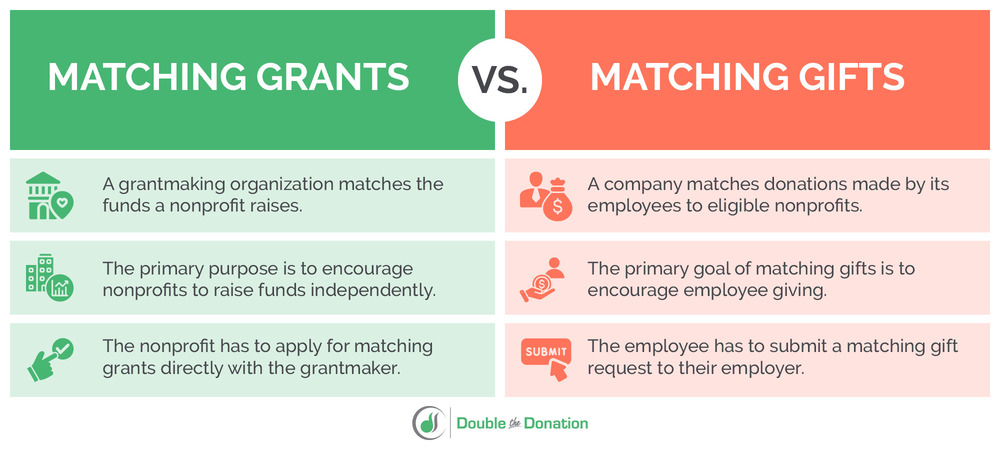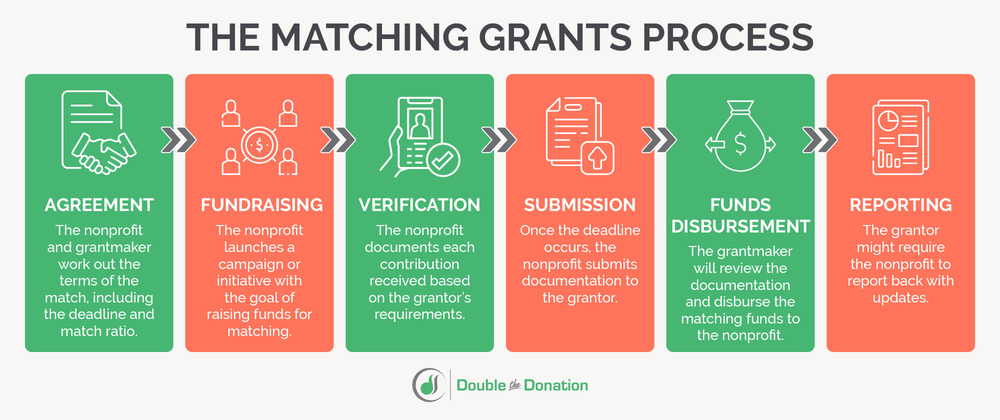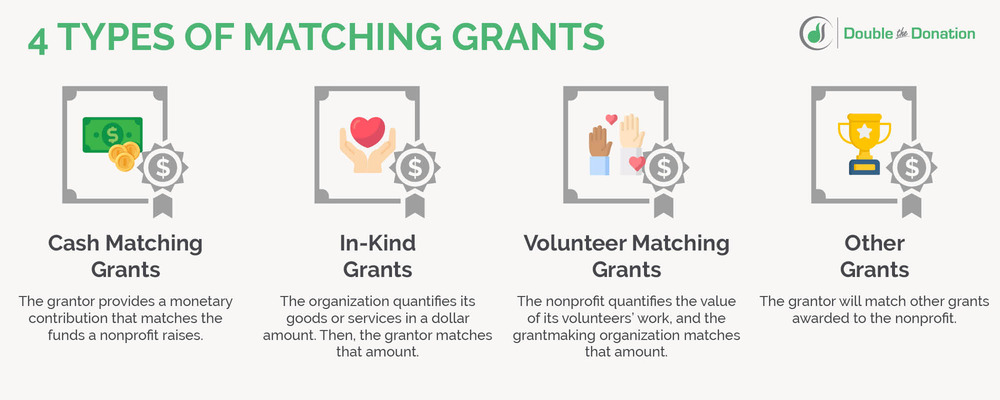What Matching Grants for Nonprofits Are and How to Find Them
Imagine a world where you could magically double the funds your nonprofit raises. You’d be able to accomplish twice as much for your mission without repeatedly going to your donors for larger contributions. What if we told you that there actually is a resource like this available to nonprofits?
In the world of philanthropy, there’s a game-changer that amplifies the impact of charitable giving and fosters a sense of shared purpose. It’s called matching grants!
In this article, we’ll delve into the essentials of matching grant programs. Along the way, we’ll share insight into what they are, where to find them, and how you can start leveraging this awesome resource. Here’s a rundown of what you’ll learn:
- What Are Matching Grants?
- The Difference Between Matching Grants and Matching Gifts
- The Benefits of Matching Grants for Nonprofits
- How Do Matching Grants Work?
- Types of Matching Grants for Nonprofits
- How to Get A Matching Grant for Your Nonprofit
We’re all about corporate philanthropy and its incredible power for nonprofits, so we’re excited to share the power behind these transformative grants. Let’s dive in!
What Are Matching Grants?
Matching grants are grants provided by corporations, foundations, or individuals to nonprofit organizations wherein the corporation agrees to match a certain amount of money that the nonprofit raises.
Matching grants require your nonprofit to contribute to your fund like the grantor does. When applying for a matching grant, you’ll agree to contribute a specific amount to your own campaign. Then, if you win the grant, the grantor will match the funds your nonprofit pledged. Usually, this is at a 1:1 or 2:1 ratio. While a 1:1 match means the funder will contribute the same amount, a 2:1 match means they will put in twice as much as your organization does.
In contrast to traditional grants where nonprofits are given a specific amount of money upfront, matching grants encourage nonprofits to raise money independently. For example, a nonprofit might have a matching grant where the grantor agrees to double every donation made through fundraising activities.
To acquire a matching grant, nonprofits often need to apply directly with the corporation. The corporation will set specific eligibility guidelines, and the nonprofit must submit a proposal stating how it will spend the money to further its mission.
The Difference Between Matching Grants and Matching Gifts
At Double the Donation, we’re experts in the matching gifts field. While matching grants and matching gifts are similar, there are a few distinct differences. Let’s explore the primary ways matching grants and matching gifts vary:
- Who Provides Funding: Matching grants are donations provided by corporations to nonprofit organizations. The company agrees to match a certain amount of money the nonprofit raises. Meanwhile, corporate matching gifts are a form of corporate philanthropy in which a corporation matches donations made by its employees to eligible nonprofit organizations.
- The Goal: While the goal of matching grants is to encourage nonprofits to fundraise independently, the goal of matching gift programs is to encourage employees to support charitable causes. When an employee donates to an eligible nonprofit, they’ll submit a request to their employer, asking them to make an additional contribution to the same organization. Their employer will match the donation up to a certain amount, typically based on eligibility guidelines.
- The Request Process: A nonprofit must apply for matching grants with the grantmaking corporation. For matching gifts, employees need to initiate the match process. After donating, the employee will submit a matching gift request to their employer, providing documentation of the donation.
To summarize, matching grants involve corporations providing grants to nonprofits on a dollar-for-dollar matching basis to support specific projects or fundraising efforts. Matching gifts require corporations to match donations made by their employees to nonprofits. While both types of programs aim to increase the impact of charitable giving, they differ in terms of initiation, purpose, and application.
In both cases, online platforms can help nonprofits uncover match opportunities and their requirements. For matching gifts in particular, our auto-submission tools can even submit a donor’s match request on their behalf. When a qualifying donor opts into auto-submission while donating, our tools will automatically confirm their eligibility and submit a match request to their employer on their behalf.
Leveraging Matching Gifts
To get started with matching gifts, watch this video that’s packed with matching gift tips that’ll set your organization up for success. You’ll learn best practices for educating donors and leveraging a matching gift database:
From appointing a matching gift specialist to proactively researching donors’ eligibility, there’s a lot you can do to leverage matching gifts at your organization. Armed with this knowledge, your team can make the most of these CSR programs.
The Benefits of Matching Grants for Nonprofits
Matching grants require quite a bit of work to set up initially, including building a relationship with a grantor, creating a grant proposal, and deciding the terms of the grants. Fortunately, the results are likely to more than make up for the time and effort spent.
Here’s a rundown of the benefits of matching grants you can share with your fundraising team to attain their buy-in:
- Funding boost: Matching grants provide additional funding for your cause, multiplying individual donations by two or even three times their original value. This means your nonprofit’s projects can have a greater impact.
- Increase in donor satisfaction: When donors give a campaign where matching will be applied, they’ll know they’re making a bigger impact on your cause. If someone gives $50, they’ll be excited knowing that their gift will actually be worth $100 thanks to the contributing company.
- Potential partnerships: While working with grantors, you can show that your nonprofit is determined to make a difference and worth investing resources into. In turn, you can establish relationships with funders and potentially secure future support through ongoing partnerships.
From the grantor’s perspective, matching grants and similar CSR initiatives position them as socially responsible and help them give back to their communities. This can help companies present themselves as positive places to work, which will help to boost employee morale and attract top talent.
How Do Matching Grants Work?
At this point, you know the basics of matching grant programs and are ready to learn how the process works. First, decide which type of matching grant to apply for. As we mentioned, consider the assets your nonprofit currently has.
While applying for any grant will follow the same general process, we’ll look at the process for a cash matching grant to keep things simple:
- Agreement: Identify a potential matching grant opportunity. This could be through a corporate philanthropy program, a foundation, or an individual willing to provide matching funds. During this stage, you and the grantor will work out the terms of the match, such as the ratio (e.g., 1:1, 2:1, or more) and maximum amount.
- Fundraising: Your nonprofit launches a specific fundraising campaign, event, or initiative with the goal of raising funds. This campaign should be designed to encourage donors to contribute to the cause, knowing their contributions will be matched by the grantor. Your donors can give to the fundraising campaign via various payment methods, such as online donations, checks, or cash.
- Verification: Your nonprofit documents each donation received during the campaign. Based on the grantor’s requirements, documentation might include donor information, contribution amounts, and payment receipts.
- Submission: Once the campaign wraps up or you reach the deadline the grantor set, your nonprofit submits documentation of all eligible donations to the grantor.
- Matching funds disbursement: The grantor reviews the documentation to ensure each donation meets the agreed-upon criteria. Once everything is in order, they’ll disburse the matching funds to your nonprofit. Now, your organization is free to use the funds to further your mission, support specific projects, or address urgent needs.
- Reporting: In some cases, grantors require the benefitting organization to provide reports or updates. These updates might include how you are using the matched funds or how they’re impacting your organization’s mission.
The process will vary depending on the grant type, but this is generally what to expect when pursuing this funding opportunity.
Types of Matching Grants for Nonprofits
When it comes to grant matching, there are a few key types to be aware of.
Consider your nonprofit’s assets when applying for different matching grants. Let’s dive into the different types of matching grants, so you can determine the best fit for your organization.
Cash Matching Grants
This grant involves a grantor providing a nonprofit with a monetary contribution that matches the funds raised by the organization at a dollar-for-dollar rate. If a nonprofit raises $10,000 and has a 1:1 cash matching grant, the funder would provide an additional $10,000.
For example, a grantor may match donations made by individuals during a specific period or fundraising campaign. Similar to matching gifts, this encourages donors to give more since they know their contributions will be matched.
In fact, 1 in 3 donors indicates they’d give a larger gift if their donation will be matched.
In-Kind Matching Grants
Unlike cash matching grants, this type of grant requires you to quantify the value of your resources. When filling out the grant application, your nonprofit will quantify its goods, services, staff contributions, volunteer hours, or other non-cash contributions in a dollar amount. You’ll use this estimation to meet the funder’s match requirements.
When searching for this type of funding, you’ll need to ensure you’ve accurately quantified the value of your non-monetary resources. For instance, this might involve documenting volunteer hours, valuing donated goods or services at fair market prices, or using accepted industry standards for valuation.
Volunteer Matching Grants
With this type of matching grant, the grantor promises to match the value of volunteer hours contributed by a nonprofit’s supporters. This type of grant is very similar to company volunteer grants, a CSR program in which a company donates to a nonprofit based on how much its employees volunteer.
For a volunteer matching grant, your nonprofit needs to provide information regarding how many volunteers you have and how many hours they worked during a specific time period. For example, let’s say a volunteer contributes 10 hours. In turn, the grantor might provide a monetary donation that equates to the value of those hours worked.
The current estimated value of each volunteer hour is nearly $32, which can add up quickly.
Other Grants
Grantors might allow you to use other grants you’ve received for matching purposes. Also called “braided funding,” this process involves “weaving” together different funding streams to support a specific project or initiative, hence the name.
For example, a nonprofit working on a community development project might secure a matching grant from one foundation, in-kind donations from a local business, and individual donations from community members. By combining these funding sources, the nonprofit can maximize the impact of its project while meeting the requirements of the matching grant.
How to Get A Matching Grant for Your Nonprofit
Whether you’re unsure where to look or need help applying, getting started with matching grant programs can be a tricky process. Keep reading to learn how to bypass any barriers!
Know Where To Find Matching Grants
You can find matching grant opportunities in many of the same places you would traditional grants. Discover matching grant opportunities by visiting the following resources:
- Foundation websites. Many foundations and grantmaking organizations offer matching grant programs. Visit the websites of local, state, and national foundations to explore available grant opportunities.
- Grant databases: Online platforms like Grants.gov, GrantStation, and Candid are great resources to check for grants. These databases provide information on different types of grants, including matching grants.
- Local Government: Explore grant opportunities from local government agencies and municipalities. They may offer matching grants for community projects and initiatives.
- Grant Alerts: Set up grant alerts from grant database websites. You can customize these alerts to receive emails when matching grant opportunities that align with your organization’s focus areas become available. USDA.gov is a great option for nonprofits interested in grant alerts.
You can also always join nonprofit associations, subscribe to publications related to nonprofit funding, or contact community foundations in your area!
Remember, corporate matching gifts are another easy solution for getting in on the gift-matching action. Look to your corporate partners and pay attention to where your donors work.
Then, look into these opportunities using a matching gift database. You can locate relevant matching gift opportunities and prompt donors to fill out a match request.
Write A Compelling Matching Grant Application
The application process for matching grants is pretty similar to that of traditional grants, but in most cases, the application will require you to go into more detail about how funds will be used. Grantseeking can get competitive, so put in the effort to craft a tailored application that stands out to funders.
As you get started, remember these tips for writing a compelling matching grant application:
- Understand the guidelines.A big pain point for grantors is when applicants don’t follow the rules! Thoroughly review the funder’s grant guidelines and eligibility criteria. Check all instructions before spending time completing the application. That includes everything from including sufficient financial documentation to submitting the application by the deadline.
- Create a strong case for support. Clearly articulate the problem your project aims to address and the impact it will have. Use data, statistics, and compelling stories to build a strong case for why your project is necessary.
- Demonstrate alignment. Before starting your application, ensure your organization and project align with the funder’s priorities. In your grant proposal, highlight shared values and goals between the two groups.
- Craft a compelling narrative. Write a persuasive narrative that tells your organization’s story and why your nonprofit, specifically, is the right organization to complete your project. Use concise, impactful language that’s easy to understand.
- Customize each application. Tailor your application for each specific matching grant opportunity. Also, avoid generic templates since funders appreciate personalized proposals.
- Highlight your resources. Grantmaking organizations want to know that your nonprofit has the fundraising capacity to meaningfully use the matching grant. Include proof via revenue statements or other financial documents to give your application legitimacy.
Are you still unsure of your grantseeking abilities? You can always seek feedback from nonprofit consultants or work with a grant writer. They know what funders are looking for and what will make your application stand out.
If your application isn’t approved, seek feedback from the funder, too. You can take their advice and apply it to future applications. Understanding the grantmaker’s mindset will put you in a much stronger position moving forward.
Wrapping Up: Multiplying Impact With Matching Grants
Matching grants have a ripple effect. Each single donation made during a matching grant campaign is magnified, providing even more support for your mission.
At this point, you should have everything you need to get started with matching grants. Start locating and applying for matching grant programs.
If you’re curious about other ways to multiply impact, explore these nonprofit fundraising and corporate philanthropy resources:
- Get to Know the Basics of Corporate Matching Gift Programs. Matching gifts are an easy way to multiply donors’ impact. They’re not classified as matching grants but can have just as much (if not more) of an impact on your cause. Explore this guide to learn the basics of this opportunity.
- Matching Gift Auto-Submission + CSR Platforms | What to Know. Matching gift auto-submission is the latest and greatest innovation in matching gift technology. Learn all about how your nonprofit can leverage it to multiply donations every day.
- What is Corporate Giving? The Ultimate Guide to Earning More. Matching grants are just one part of the corporate giving world. Discover different opportunities your nonprofit has to tap into corporate philanthropy.









